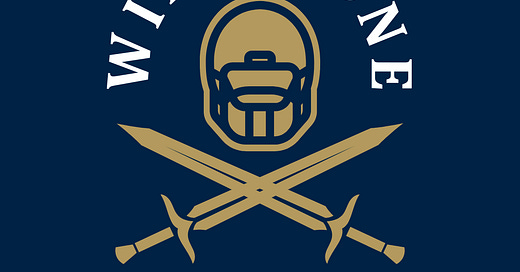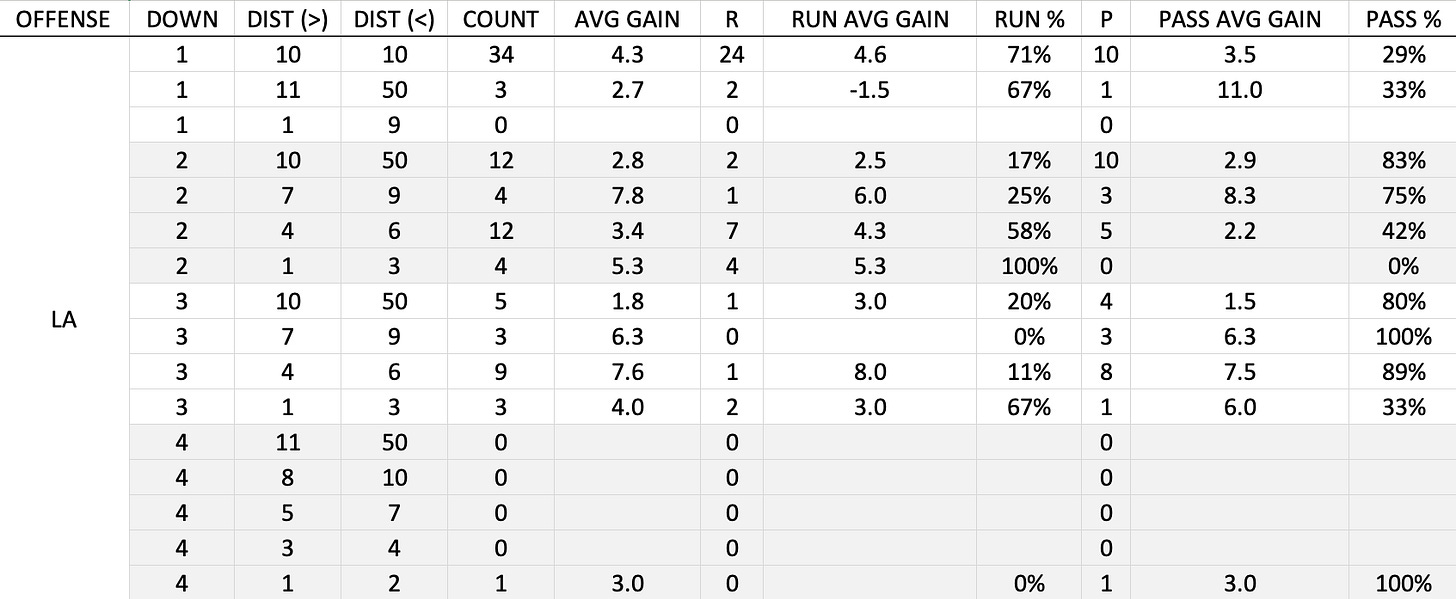What Should You Call in the High Red Zone?
What are the league’s best offenses calling when they enter the Red Zone?

The High Red Zone to me is between 10 and 20 yards from the opponent’s end zone. This space is critical, as it is the last place on the field in which most passing concepts can still be called with little changes to vertical spacing and less-aggressive safeties. Does that mean you should only pass, or how often should you run? In this article, we’ll take a look at how Sean McVay, Kyle Shanahan, Mike McDaniel, and Matt LaFleur handle this area of the field and draw some conclusions for us at lower levels with a cutup of EVERY High Red Zone play from each team, nearly 500 plays in total! We won’t be diving into concepts themselves, just comparing runs and passes, so be sure to dive into the film and see exactly how each team was successful!
First downs have been divided into 1 & 10, 1&>10, and 1&<10. This will help us see normal first down calls as well as adjustments as a result of penalties. Second and Third downs are divided into Short (1-3), Medium (4-6), Long (7-9), and Extra Long / XL (10+). Fourth downs are another important aspect of this study, and they are divided into 4&1-2, 3-4, 5-6, 8-9, and 10+. We will see how all 4 play callers handled each of these situations in terms of calling runs and passes, average yards gained for each, and combine all the data for general system totals.
Another important data point is how often these teams actually scored. That is the end goal of any drive, and making conclusions to that effect is the aim of the article. Three of our four teams ranked in the Top 10 of the NFL in Red Zone TD Percentage: SF (1st – 68%), MIA (3rd – 66%), LA (8th – 60%). Green Bay landed just in the bottom half of the league at 17th overall with a Red Zone TD Percentage of 53%.
RAMS
It all starts on 1st & 10, and the Rams were much more successful running the ball than passing, averaging over a yard more running than passing on 28 more attempts. In total, an average of 4.2 yards put them in a good place to begin a series in the High Red Zone. Two numbers really stand out to me on 2nd down. On their four 2nd & Long plays, they averaged nearly 8 yards! That’s either a first down or close to it, depending on just how “long” 2nd & Long was on that play. 3 of the 4 plays were passes that averaged over 8 yards, and even the lone run was a 6 yard gain to set up for a 3rd & Short attempt. The other second down situation that stands out to me is 2nd & Short. I’m a firm believer in analytically-guided decision-making, and analytics generally suggest that there is no such thing as a free down, which is generally in reference to considering 2nd and Short as a “shot play” down with the mindset that the first down will be picked up if the shot pass falls incomplete. However, this close to the endzone, I would be pretty aggressive in trying to get the ball in the endzone before the field shrinks even more, and McVay called runs on all four 2nd & Short opportunities. They averaged over 5 YPC on such runs.
Compounding my thoughts of being more aggressive on 2nd & Short is the fact that the Rams were very efficient on 3rd & Short-Medium, so even if that pass to the end zone fell incomplete on 2nd & Short, they were still likely to get the first down on the next play. They averaged 3 yards on 3rd & Short, which I consider to be 3 yards or less, meaning they averaged the most yards required to be in that category. Even on 3rd & Medium, they averaged more yards than necessary, with a clip of 7.6 yards per play, all but one a pass. 3rd & Long-XL tell a bit of a different story, but I believe part of that to be the fact that even with all the kicking troubles the Rams endured in 2023, field goals inside of the Red Zone are a non-negotiable for any kicker on an NFL roster. It can be better to play it safe with shorter passes that have a chance for YAC to get across the first down marker while limiting chances for a sack or interception.
Sean McVay is well-known for his conservative approach to fourth downs, much to the chagrin of fans (myself included) among the previously mentioned kicking woes. Even so, only 2 fourth downs were attempted in the High Red Zone, a run and a pass, both on 4th & short, both gaining 3 yards and a new set of downs.
Don’t forget out live clinic on Sunday night (8:30 PM CT - April 28, 2024) with Anthony Ivany on QB Play in a Shanahan/McVay Offense! It is for paid subscribers only, so be sure to upgrade your subscription and enjoy all the benefits of a premium subscription to Wide Zone Warriors!
Keep reading with a 7-day free trial
Subscribe to Wide Zone Warriors to keep reading this post and get 7 days of free access to the full post archives.





